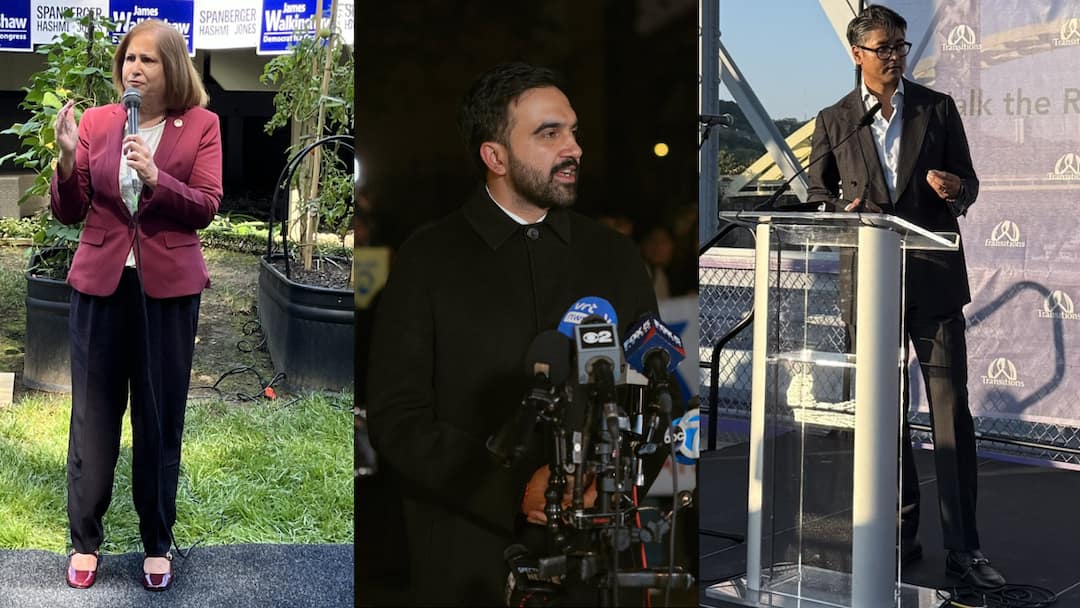Democrat Abigail Spanberger clinched victory in Virginia’s gubernatorial race on Tuesday, defeating Republican Lieutenant Governor Winsome Earle-Sears in a closely watched contest that delivers Democrats a crucial prelude to the 2026 midterm elections. Her win marks a historic first as Spanberger will become Virginia’s first woman governor, succeeding outgoing Republican Glenn Youngkin and ending GOP control of the executive office.
Addressing jubilant supporters in Richmond, Spanberger said the result sent “a message to every corner of the commonwealth, a message to our neighbours and our fellow Americans across the country.” She added, “We sent a message to the whole world that in 2025, Virginia chose pragmatism over partisanship. We chose our commonwealth over chaos.”
Hashmi Breaks Another Barrier
In a second milestone for Virginia Democrats, Ghazala F. Hashmi won the race for lieutenant governor, succeeding Earle-Sears and becoming the first Muslim woman ever elected to statewide office in the United States.
Campaign Focused On Economy And Moderation
A former CIA case officer and U.S. congresswoman, Spanberger, 46, built her campaign around pragmatic economic messaging — an approach analysts say could serve as a blueprint for Democrats seeking to reclaim swing voters in next year’s national races. She framed her economic arguments as a direct contrast to Donald Trump’s policies, investing heavily in advertising that tied Earle-Sears to the president’s agenda.
Spanberger toured extensively across the state, including Republican-leaning areas, positioning herself as a centrist who could appeal to moderates. Alongside her economic focus, she defended abortion rights, a potent issue in the last Southern state yet to impose new restrictions or bans, and criticised the Trump administration’s Department of Government Efficiency and its role in the federal government shutdown, which she said harmed Virginia’s large federal workforce.
Swing Voters And Historical Trends
Her message resonated with both Democratic loyalists and swing voters who had backed Youngkin four years earlier. The outcome continues a long-standing Virginia trend, which is the fact that since 1976, the state has elected a governor from the opposite party of the sitting first-term US president.
Republicans, meanwhile, face renewed introspection after another defeat in a key battleground. Trump gave Earle-Sears only tepid backing and did not campaign for her, underscoring ongoing divisions over the GOP’s direction and electability in competitive states. Earle-Sears, 61, would have been the first Black woman ever elected governor in the US.
Voters Cite Trump Fatigue And Shutdown Impact
For many Virginians, the election was less about personalities than about policy and stability. Sherry Kohan, 56, an accountant in Arlington, said she previously identified as Republican but could no longer support Trump-era politics. “My vote for Spanberger was a vote against Trump,” she said.
Stephanie Uhl, 38, a Defence Department employee working without pay during the shutdown, also voted for Spanberger. “I can afford (it) just fine,” she said, “but it affects so many other people.”
Background And Bipartisan Credentials
Spanberger leaned heavily on her record of public service and cross-party cooperation. As a mother of daughters in Virginia’s public schools and a former representative of a swing district, she highlighted her ability to bridge divides. Her career in Congress began with attention to lower-profile but locally significant issues such as rural broadband access, drug trafficking, and veterans’ services.
Those credentials helped her counter Republican attacks on cultural and social issues. Earle-Sears accused Spanberger of extremism on civil rights and transgender health care, but Spanberger reiterated her belief that local school districts should decide whether transgender students participate in sports. She, in turn, portrayed Earle-Sears as out of step with Virginia’s moderate electorate.
Echoes Of 2018 And National Implications
Spanberger’s disciplined campaign recalled the Democratic midterm strategy of 2018, when a wave of women candidates with national security or military backgrounds helped the party reclaim the US House. Among them was Representative Mikie Sherrill, who also contested for governor in New Jersey this year.
Together, these women have come to symbolise a centrist, service-oriented Democratic brand at a time when the party’s progressive wing, represented by figures such as Zohran Mamdani, gains traction nationally.
Governing Challenges Ahead
As she prepares to take office, Spanberger faces mounting economic headwinds, including rising utility costs, higher unemployment, and the lingering effects of the federal workforce cuts under Trump’s administration. Her ability to advance policy will depend on legislative control as Democrats are seeking to retain their House of Delegates majority, while the state Senate remains in Democratic hands. If successful, the party could secure a governing trifecta in Richmond.
Late-Stage Controversy And Fallout
Spanberger’s campaign was briefly overshadowed by controversy in October when reports surfaced that Jay Jones, the Democratic nominee for attorney general, had sent a 2022 text suggesting the former Republican House speaker should receive “two bullets to the head.”
Republicans, including Trump and Earle-Sears, demanded Jones withdraw from the race. Jones apologised but refused to step aside. Spanberger condemned the language but stopped short of rescinding her endorsement.
“I have denounced political violence, political rhetoric,” she said during her sole debate with Earle-Sears, “no matter who is leading the charge.”



